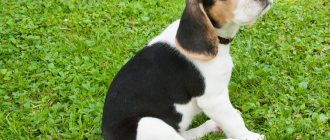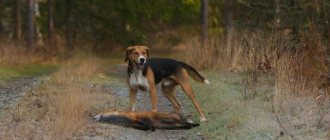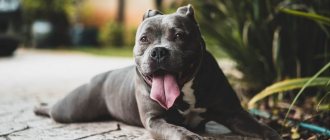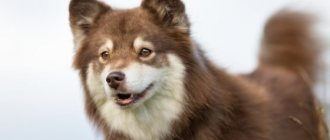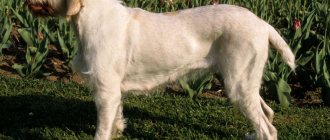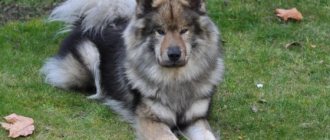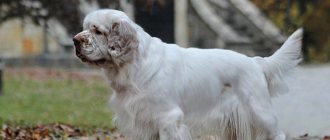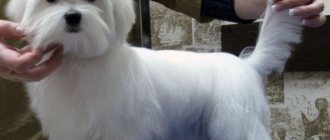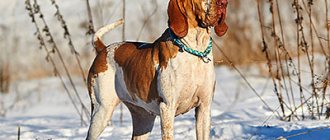The Samoyed Laika or Samoyed is a snow-white, fluffy dog whose homeland is the north. She has natural beauty and a friendly personality.
The dog has light thick fur, black eyes and a proportional build.
Since ancient times, Samoyeds have helped people survive in the harsh conditions of the server. At the same time, they were distinguished by intelligence, endurance and obedience.
Now he is a family dog, an excellent watchman and companion.
In this article we will talk about why Samoyeds are called that, what features they have and who such pets are suitable for.
origin of name
There are several versions of why this breed is called that.
Some experts believe that the origin of the name comes from the server people living in Russia. In ancient times, the name sounded exactly like that - Samoyeds. The modern name of the nationality is Nenets.
To be more precise, this nation was named from the ancient word “samoyad”, which means “self-contained”, “closed in itself”. This can be understood as the closed way of life of an ethnic group and its closedness from other people.
Another version says that the name comes from the words “sam” and “to go,” since residents of the north often traveled on skis.
There are also versions that the dogs were called Samoyeds because of their color. After all, when they were transporting the team, they were almost invisible in the snow and it seemed that the team was driving itself.
Another option where the name of the breed came from is the expression “saam-jedna”, which means “land inhabited by the Sami”.
NOTE!
The Sami are a small ethnic group of northern peoples living in Norway, Finland and Russia.
Why is it called that?
I would like to immediately clarify, before the reader has time to imagine an animal eating itself, that the name is not associated with any horrors. Throughout almost the entire period of their existence, which is more than three thousand years, our heroes belonged to different tribes of the Samoyed peoples.
We are talking about small nationalities living in the north of Russia. They have their own language, and the name comes from a slightly modified form of the calculus “oneself” or “oneself one”.
Subsequently, in the thirties of the last century, a time of change and new interpretations, Soviet linguist G.N. Prokofiev proposed renaming the small nations Samoyed. So as not to frighten Soviet people with hints of cannibalism. But no one began to rename the Samoyeds’ pets. So even a modern Samoyed owner is often forced to explain the origin of the name of the breed, justifying his pet.
History of appearance
It is believed that the ancestors of the current Samoyeds were brought to Europe by the Englishman Joseph Wiggens during the establishment of trade relations with Siberia. But this fact has no documentary evidence.
The North of Russia is considered the homeland of Samoyeds, and the history of the breed goes back centuries. For many years, the Nenets used this breed as household helpers. Dogs served as guards, “workhorses”, and were used in hunting.
They were also wonderful nannies. On cold server nights, the dogs warmed the babies with their bodies. For many years they did not leave their homeland. And only in 1889, the Englishman Ernst K. Scott took several individuals to England, after which a nursery was organized.
This is how the breed was saved from extinction. Over time, thanks to its qualities, the breed began to gain popularity in Europe.
It is known that there were several Samoyed huskies at the court of King Edward VII. And in 1920, the English Samoyed Association was organized, where breed standards were approved. Later the breed was recognized by other European countries.
At this time, in their historical homeland, Samoyeds were undeservedly forgotten and almost disappeared. Only in 1989 were dogs brought to the USSR from Denmark.
Nowadays Samoyeds can be found all over the world.
The Samoyed husky in its modern form has not lost its hunting qualities and has a pursuit instinct. Such a dog can hunt mice, birds, lizards or other small animals.
History of the breed
The name for a dog is strange, and many are interested in why the Samoyed husky was called that.
Don't worry, he doesn't eat himself under any circumstances.
The homeland of Samoyeds is northern Russia. However, their population was almost completely lost. The breed was recreated not in Russia, but in England.
The Siberian Samoyed has been an assistant and companion for many centuries for a group of tribes of the Samoyed group. This group includes the Nenets, whose dogs (Nenets Laikas) are considered the ancestors of the Samoyeds. There is a version about the domestication of the polar wolf - the Samoyed is similar to it in many ways.
Family
Aboriginal dog; It is possible that the ancestors of these little huskies saw mammoths.
Samoyed dog - yes, husky - no. Don't say this word in front of the dog owner. Samoyed, Samoyed dog - these are the correct names.
And with the name everything is simple. The Nenets, who had the ancestors of Samoyed dogs, were previously called Samoyeds, Samoyeds, Samoyeds. Hence the dog was called Samoyed.
There are three versions of the origin of the breed.
- The breed was created by breeders based on Nenets Laikas.
- The breed was created by British zoologist E.K. Scott based on the aboriginal Samoyeds (almost disappeared). Scott brought a brown dog to England from an expedition to the Samoyed tribes; then he brought a cream colored bitch and a white dog from the Polar Urals. Basically, these dogs became the basis for the Western Samoyed breed.
- The English captain J. Wiggens was looking for ways to trade with the Northern regions of Russia. From there I took out cute dogs. The version is not documented.
To this day, in the surviving reindeer herding farms and in the private property of the Nenets, Nenets Laikas work for their intended purpose. They herd deer, protect children, and at night warm their tired owners with their warmth.
Unofficially, there are three types of Samoyed:
- bearish;
- wolfish;
- fox
Interesting Facts
Interesting Facts:
- Some Samoyed owners notice their habit of rolling on slippery paths when walking. And when climbing a mountain, the dog runs ahead and helps the owner get up.
- Such dogs are often kept in hospitals for the mentally ill. Here they help patients cope with mental illness.
- Representatives of the Samoyed breed really do not like to swim. Apparently, origin plays a role. In the homeland of these dogs, water is called wormwood, which translated means death.
- The pet completely lacks the characteristic dog smell.
- In the north, Samoyeds are used as hunters of walruses, deer and bears.
- According to one version, the ancestor of the Samoyed is a cross between a polar wolf and an arctic fox.
Origin story
Do you want to get a Samoyed?
Yes
57.78%
While I'm thinking
26.67%
Has already!
15.56%
The Arctic Spitz is one of the oldest northern breeds, with a history going back 3,000 years. For many centuries it was used by northern peoples in many areas of life.
The aboriginal husky gained fame in Europe only in 1890, when polar explorer E. Scott brought it to Great Britain. Scott himself emphasized that dogs differ in head shape and divided them into fox, bear, and wolf types. During breeding, the British tried to ensure that the animals did not lose their features. In 1909, the English breed standard was adopted.
A lively mind, love for people, devotion, beautiful appearance - ensured popularity. Sami huskies have attracted interest all over the world, especially in the USA and Canada. During selection over 100 years, 2 types appeared: the wolf type, bred in America, and the bear type (English).
In Russia, the indigenous, Russian Samoyed has practically disappeared. The breed returned to its homeland from other countries, primarily from England.
Photo and description
The Samoyed is a medium-sized , strong, muscular and slender. This pet is distinguished by its extraordinary beauty, because the Samoyed is a white, fluffy dog with dark eyes and thick hair.
The dog has a conical muzzle, and the skull is wide and slightly convex.
The nose is black, as are the lips. The bite is scissor-shaped.
Particular attention should be paid to the “facial expression” of the dog, since the whole range of emotions can be reflected on its face. This is where the expression came from - the Samoyed smile.
The eye shape is almond-shaped. The pet's eyes are black, deep-set and slightly slanted. Any eye color other than black is considered a breeding defect.
The dog has small erect ears, triangular in shape, slightly rounded at the tips.
The body of the Samoyed is much longer than the height at the withers, but the dog is proportionally and harmoniously built.
The neck is of medium length, quite powerful, curved.
The tail is set high and carried over the back. In a state of calm, the dog can lower it.
The pet's coat is thick, long and very dense, with a thick undercoat. The neck and shoulders are decorated with a fluffy collar, and beautiful “pants” are on the hips.
Color - from snow-white to cream.
IMPORTANT!
If the Samoyed's color contains pale brown or light coffee tones, this indicates that the breed is not pure enough.
Description of the breed
FCI Standard No. 212 dated 7.22.1997 “Samoyed (Samoyed dog)” Group 5 “Spitz and primitive type breeds” Section 1 “Northern sled dogs”
The ideal height at the withers is 57 ± 3 cm for males and 53 ± 3 cm for females.
Male weight is from 25 to 30 kg, females from 17 to 25 kg.
The main features of the exterior are shown in the table.
| HEAD | Powerful, wedge-shaped with erect small ears. |
| EYES | Dark brown, with a black outline, deep set. The expression is kind, lively, “smart.” |
| EARS | Erect, rather small, thick, triangular and slightly rounded at the ends; can be mobile; set rather high and wide on a broad skull. |
| TEETH | Correct and complete scissor bite. Teeth and jaws are strong. Complete set of teeth. |
| NECK | Medium length, muscular, with a proud posture. |
| BREAST | Wide, deep and long; the depth almost reaches the elbows. The ribs are well sprung. |
| PAWS | The limbs (both front and rear) are straight and parallel, with excellent developed muscles. |
| TAIL | Set on high. When alert, the dog carries its tail curled over its back or side, but when at rest it can lower it, and then it reaches the hock joints. |
| WOOL | Dense, abundant, dense: soft, short undercoat and long, harsh main coat. In male dogs, a collar forms around the neck and shoulders. There are “pants” on the hind legs, the tail is profusely pubescent. |
| COLOR | White, cream, white with biscuit. |
The lips are black, tightly fitting, with slightly raised corners, which creates the effect of a smile. This is one of the characteristic differences from other dog breeds.
Interesting fact: Samoyeds' fur fluffs up in the cold. And the colder it is, the more “fluffy” the dog will be.
The color should not contain a pale brown tint.
There is an unofficial classification by K. Scott, based on the shape of the dogs' heads , according to which Samoyeds are divided into:
- bear-shaped;
- fox-shaped;
- wolf-like.
The life expectancy of a Samoyed dog is 14-15 years.
Character traits
Samoyeds are kind and obedient dogs, always ready to play and have fun. They are always full of life and enthusiasm, friends of children and other pets. Sometimes they are too trusting and friendly, which negatively affects their qualities as guards.
Such pets enjoy spending time with their owner and members of the family. No matter what they do, the dog will always be there.
If you don't give your dog enough attention, he starts to get bored and anxious. Such pets are very susceptible to separation anxiety from their owner, so inattention to them can lead to behavioral disorders. A pet left for a long time may bark, howl, chew things, or shit in inappropriate places for no reason.
Samoyeds are very smart, independent and stubborn, which means they need a firm and principled owner. In addition, they get along well with children and other animals.
As for Samoyed puppies , they can be too active, talkative and annoying. Such traits in a pet remain for approximately 2 years.
Dogs are perfectly adapted to live outdoors and can easily be kept in the yard. They are independent, calm and affectionate, and proper training makes them ideal companions.
It is also worth saying that Samoyeds are quite proud, they love to be the center of attention and willingly participate in any family activities. In addition, they are characterized by curiosity and mischief.
Advantages and disadvantages
Pros:
- Friendly character and love for children. This breed is very patient and affectionate with children. The Samoyed can endlessly tolerate the whims and pranks of kids.
- Lack of aggression. The Samoyed is a dog for the whole family - a wonderful companion, friend and nanny. Moreover, the dog is friendly not only with members of the seven, but also with strangers.
- Devotion to the owner. The Samoyed is very attached to its owner and family members.
- Highly intelligent, the dog is highly trainable and happily follows commands.
- Cheerful and positive disposition. The Samoyed enjoys participating in all family events, entertainment and everyday activities.
- Easy to care for. The dog requires almost no bathing or nail trimming. In addition, Samoyeds have good health and rarely get sick.
- Calm attitude towards other pets. Samoyeds get along well with cats and other dogs.
Minuses:
- Tendency to shed. The reason is fluffy and thick wool.
- The need for physical activity. The breed is not suitable for elderly and lazy people.
- The dog does not tolerate heat well, since the Samoyed’s homeland is the tundra.
- If raised incorrectly, the pet becomes wayward and disobedient.
- There is a tendency to steal. A poorly behaved Samoyed may steal or beg for food.
- High price for puppies.
- Tendency to bark and howl. If a dog is bored or yearns for its owner, then barking and howling will be its usual activities.
What the future owner needs to know
The not very euphonious name led to the fact that Samoyed huskies were once accused of almost cannibalism. Even in the nineteenth century, after the spread of dogs in England, not all lovers of four-legged animals clearly understood what the Samoyed Laika was like.
Today we can confidently say that the Samoyed is a gentle, intelligent, faithful dog that loves all family members, especially children. Samoyed huskies try to participate in all aspects of the owner’s life and be useful in everyday life.
However, the Samoyed Laika makes a very positive impression due to its spectacular appearance. At a young age, Samoyeds are quite stubborn, so they are difficult to train. Dogs are considered mature at 1–1.5 years of age.
Adult Samoyed huskies that have received an insufficient level of socialization can display hunting skills towards small pets. Despite its average size, the Samoyed Laika poses a serious danger to cats and small dogs. Even large relatives can suffer from an angry Samoyed, since the breed was bred, among other things, for hunting bears.
This is interesting! Today, the Samoyed Laika is a rare but very popular breed. No more than 2,500 adult dogs are registered in Russia.
Luxurious, white wool requires careful care. This is not just about the shedding period, when the dog needs to be thoroughly brushed every day. If not properly cared for, the Samoyed's coat turns yellow, gathers in tangles, and becomes brittle and dry.
How to properly care?
The Samoyed requires special care. The reason for this is the thick and lush fur. The dog is prone to shedding, so it should be brushed at least once a week. In addition, fluffy fur should be brushed.
It is recommended to bathe your dog no more than 2-3 times a year. After all, Samoyeds are very clean and do not have a specific dog smell.
As for the claws, there is no need to cut them; they grind down on their own.
At the same time, the Samoyed Laika's teeth require careful care. Brush your pet's teeth 2-3 times a week using meat-flavored toothpaste and a dog toothbrush.
Clean your pet's ears once a month using a cotton swab dipped in a special lotion. In this case, the tampon should be damp, not wet, so that drops of liquid do not get into the ear, otherwise it can cause inflammation of the ear canal.
Another important point is walking. Be sure to walk your dog every day. Samoyeds especially love cold and snowy weather.
NOTE!
The dog really doesn’t like to bathe, it’s really stressful for him.
Life expectancy and diseases
The average lifespan of a Samoyed is 12–13 years.
Main diseases:
- Cataract.
- Hip dysplasia.
- Diabetes.
- Pigmentation of the nasal lobe.
- Retinal atrophy.
- Deafness.
What's best to feed?
Most veterinarians recommend feeding the Samoyed dry food, as it contains the right amount of nutrients.
But natural nutrition is also acceptable. First of all, it should be said that the Samoyed must be given raw meat. This is the basis of the diet. The second important point is milk; it should be completely excluded from the diet, as it causes diarrhea in the dog.
IMPORTANT!
Do not teach your dog to feed from your hands or from the floor. She must have her own bowl and a certain time for feeding.
Diet of an adult Samoyed:
- 30% – meat (raw or cooked),
- 30% - fermented milk products (yogurt, kefir, cottage cheese),
- 20% - boiled sea fish (dogs love it very much),
- 20% - cereals, vegetables, offal (beef tripe, heart, liver).
Prohibited products:
- Chocolate.
- Eggs.
- Smoked meats.
- Potatoes and beans.
- Pork.
- Baking.
You need to feed your pet strictly 2 times a day.
You can use cheese, sugar seeds or rye crackers as a treat.
It is better to feed your pet after a walk. This promotes better absorption of food and also prevents excess weight.
